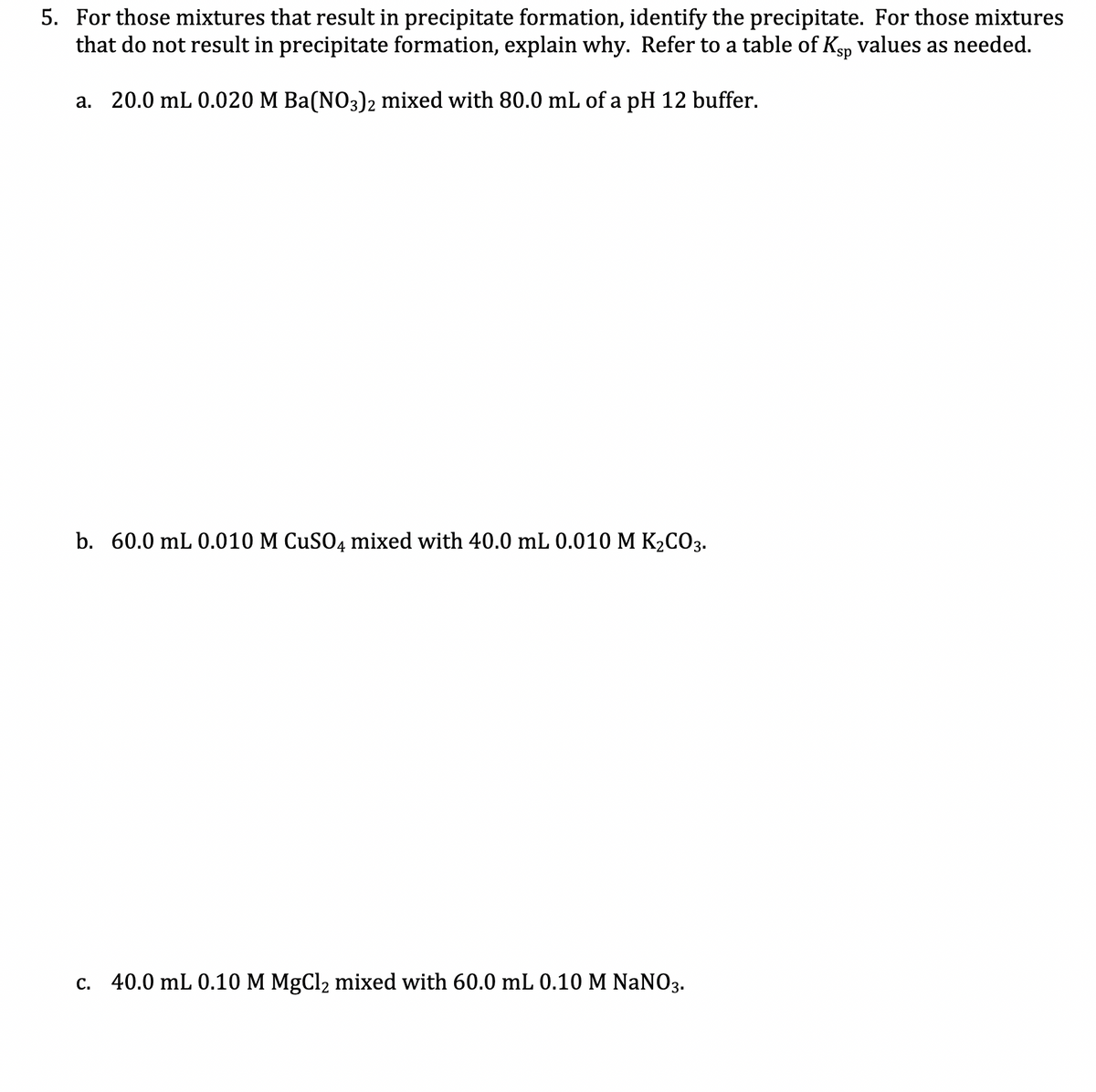5. For those mixtures that result in precipitate formation, identify the precipitate. For those mixtures that do not result in precipitate formation, explain why. Refer to a table of Kgp values as needed. a. 20.0 mL 0.020 M Ba(NO3)2 mixed with 80.0 mL of a pH 12 buffer. b. 60.0 mL 0.010 M CuSO4 mixed with 40.0 mL 0.010 M K2CO3. c. 40.0 mL 0.10 M MgCl2 mixed with 60.0 mL 0.10 M NaNO3.
Help with Part A B and C:
Ksp Values:
Ionic CompoundFormulaKsp
Aluminum hydroxideAl(OH)31.8×10–5
Aluminum phosphateAlPO46.3×10–19
Barium carbonateBaCO35.1×10–9
Barium chromateBaCrO41.2×10–10
Barium fluorideBaF21.0×10–6
Barium hydroxideBa(OH)25×10–3
Barium sulfateBaSO41.1×10–10
Barium sulfiteBaSO38×10–7
Barium thiosulfateBaS2O31.6×10–6
Bismuthyl chlorideBiOCl1.8×10–31
Bismuthyl hydroxideBiOOH4×10–10
Cadmium carbonateCdCO35.2×10–12
Cadmium hydroxideCd(OH)22.5×10–14
Cadmium oxalateCdC2O41.5×10–8
Cadmium sulfide*CdS8×10–28
Calcium carbonateCaCO32.8×10–9
Calcium chromateCaCrO47.1×10–4
Calcium fluorideCaF25.3×10–9
Calcium hydrogen phosphateCaHPO41×10–7
Calcium hydroxideCa(OH)25.5×10–6
Calcium oxalateCaC2O42.7×10–9
Calcium phosphateCa3(PO4)22.0×10–29
Calcium sulfateCaSO49.1×10–6
Calcium sulfiteCaSO36.8×10–8
Chromium(II) hydroxideCr(OH)22×10–16
Chromium(III) hydroxideCr(OH)36.3×10–31
Cobalt(II) carbonateCoCO31.4×10–13
Cobalt(II) hydroxideCo(OH)21.6×10–15
Cobalt(III) hydroxideCo(OH)31.6×10–44
Cobalt(II) sulfide*CoS4×10–21
Copper(I) chlorideCuCl1.2×10–6
Copper(I) cyanideCuCN3.2×10–20
Copper(I) iodideCuI1.1×10–12
Copper(II) arsenateCu3(AsO4)27.6×10–36
Copper(II) carbonateCuCO31.4×10–10
Copper(II) chromateCuCrO43.6×10–6
Copper(II) ferrocyanideCu[Fe(CN)6]1.3×10–16
Copper(II) hydroxideCu(OH)22.2×10–20
Copper(II) sulfide*CuS6×10–37
Iron(II) carbonateFeCO33.2×10–11
Iron(II) hydroxideFe(OH)28.0×10–16
Iron(II) sulfide*FeS6×10–19
Iron(III) arsenateFeAsO45.7×10–21
Iron(III) ferrocyanideFe4[Fe(CN)6]33.3×10–41
Iron(III) hydroxideFe(OH)34×10–38
Iron(III) phosphateFePO41.3×10–22
Lead(II) arsenatePb3(AsO4)24×10–36
Lead(II) azidePb(N3)22.5×10–9
Lead(II) bromidePbBr24.0×10–5
Lead(II) carbonatePbCO37.4×10–14
Lead(II) chloridePbCl21.6×10–5
Lead(II) chromatePbCrO42.8×10–13
Lead(II) fluoridePbF22.7×10–8
Lead(II) hydroxidePb(OH)21.2×10–15
Lead(II) iodidePbI27.1×10–9
Lead(II) sulfatePbSO41.6×10–8
Lead(II) sulfide*PbS3×10–28
Lithium carbonateLi2CO32.5×10–2
Lithium fluorideLiF3.8×10–3
Lithium phosphateLi3PO43.2×10–9
Magnesium ammonium phosphateMgNH4PO42.5×10–13
Magnesium arsenateMg3(AsO4)22×10–20
Magnesium carbonateMgCO33.5×10–8
Magnesium fluorideMgF23.7×10–8
Magnesium hydroxideMg(OH)21.8×10–11
Magnesium oxalateMgC2O48.5×10–5
Magnesium phosphateMg3(PO4)21×10–25
Manganese(II) carbonateMnCO31.8×10–11
Manganese(II) hydroxideMn(OH)21.9×10–13
Manganese(II) sulfide*MnS3×10–14
Mercury(I) bromideHg2Br25.6×10–23
Mercury(I) chlorideHg2Cl21.3×10–18
Mercury(I) iodideHg2I24.5×10–29
Mercury(II) sulfide*HgS2×10–53
Nickel(II) carbonateNiCO36.6×10–9
Nickel(II) hydroxideNi(OH)22.0×10–15
Nickel(II) sulfide*NiS3×10–19
Scandium fluorideScF34.2×10–18
Scandium hydroxideSc(OH)38.0×10–31
Silver acetateAgC2H3O22.0×10–3
Silver arsenateAg3AsO41.0×10–22
Silver azideAgN32.8×10–9
Silver bromideAgBr5.0×10–13
Silver chlorideAgCl1.8×10–10
Silver chromateAg2CrO41.1×10–12
Silver cyanideAgCN1.2×10–16
Silver iodateAgIO33.0×10–8
Silver iodideAgI8.5×10–17
Silver nitriteAgNO26.0×10–4
Silver sulfateAg2SO41.4×10–5
Silver sulfide*Ag2S6×10–51
Silver sulfiteAg2SO31.5×10–14
Silver thiocyanateAgSCN1.0×10–12
Strontium carbonateSrCO31.1×10–10
Strontium chromateSrCrO42.2×10–5
Strontium fluorideSrF22.5×10–9
Strontium sulfateSrSO43.2×10–7
Thallium(I) bromideTlBr3.4×10–6
Thallium(I) chlorideTlCl1.7×10–4
Thallium (I) iodideTlI6.5×10–8
Thallium(III) hydroxideTl(OH)36.3×10–46
Tin(II) hydroxideSn(OH)21.4×10–28
Tin(II) sulfide*SnS1×10–26
Zinc carbonateZnCO31.4×10–11
Zinc hydroxideZn(OH)21.2×10–17
Zinc oxalateZnC2O42.7×10–8
Zinc phosphateZn3(PO4)29.0×10–33
Zinc sulfide*ZnS2×10–25
* Sulfide equilibrium of the type:
MS(s) + H2O(l) → ← M2+(aq) + HS–(aq) + OH–(aq>)

Trending now
This is a popular solution!
Step by step
Solved in 4 steps









